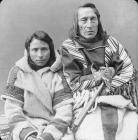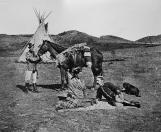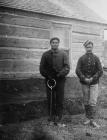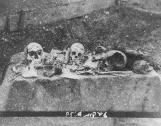2
For the police force, keeping the peace was accomplished by way of old-fashioned no nonsense attitudes. The impact of the Reserve system was a critical factor in the unrest within the Indian bands.The systematic use of the law allowed the force's members consistency in convictions, whether a fellow member of the force, or an Indian, or the lay settler.
The seriousness of the crime dictated the prisoner's, incarceration and on occasion, demise.
The ability of the mounted force to re-organize and implement strategic maneuvers at a moments notice was extremely beneficial when dealing with the Indian Rebellion of 1885.
3
Policing the old fashioned method5
Chief Bobtail was Cree leader who was strong in his dealings but respected the assigned duties of Inspector Griesbach during the Riel Rebellion. As the story is told, on May 1885, rumors of the capture of Fort Saskatchewan and the massacre of its garrison led to tense relations with a neighboring band of Cree Indians.Chief Bobtail was known to be a prominent man and when Griesbach entered camp to search and arrest the Indians that were involved with the Riel uprising, seized his horse by the bridle while a group of tribesmen covered him with their rifles.
Griesbach in turn, covered the Chief with his revolver to "make sure that if a shot was fired he would at least take one prominent Indian with him". And the result apparently "put a stop to the agitation in the Blind Man River and there was no further trouble in the area".
6
Strength and Mentorship8
The strong aptitude of the force's Commanding Officers went a long way in mentoring the Non-Commissioned Officers.Giesbach recollects his father's efforts and how through persistent and consistent laws, the mounted police "put a stop to the warfare between the Indian tribes".
9
The First Execution11
Punishment by law was general across all cultures. The first execution by hanging was in Fort Saskatchewan and was a Cree Indian named Kah-kee-see-koo-chin (Swift Runner). He was arrested by Sergeant Sam Steele on suspicions of having killed and eaten his Mother, Brother, and his own wife and five children.Swift Runner claimed that his family died of starvation and if it were not for his consumption of his deceased family members, he would have died as well.
12
Cannibalism Account14
Constable Fred Bagley recounts the location and discovery of the victims of Swift Runner.He wrote in his journal on June 7th and 8th, the details of the search party, where the bones were located, the condition of the camp and Swift Runners reaction once confronted with the evidence.




